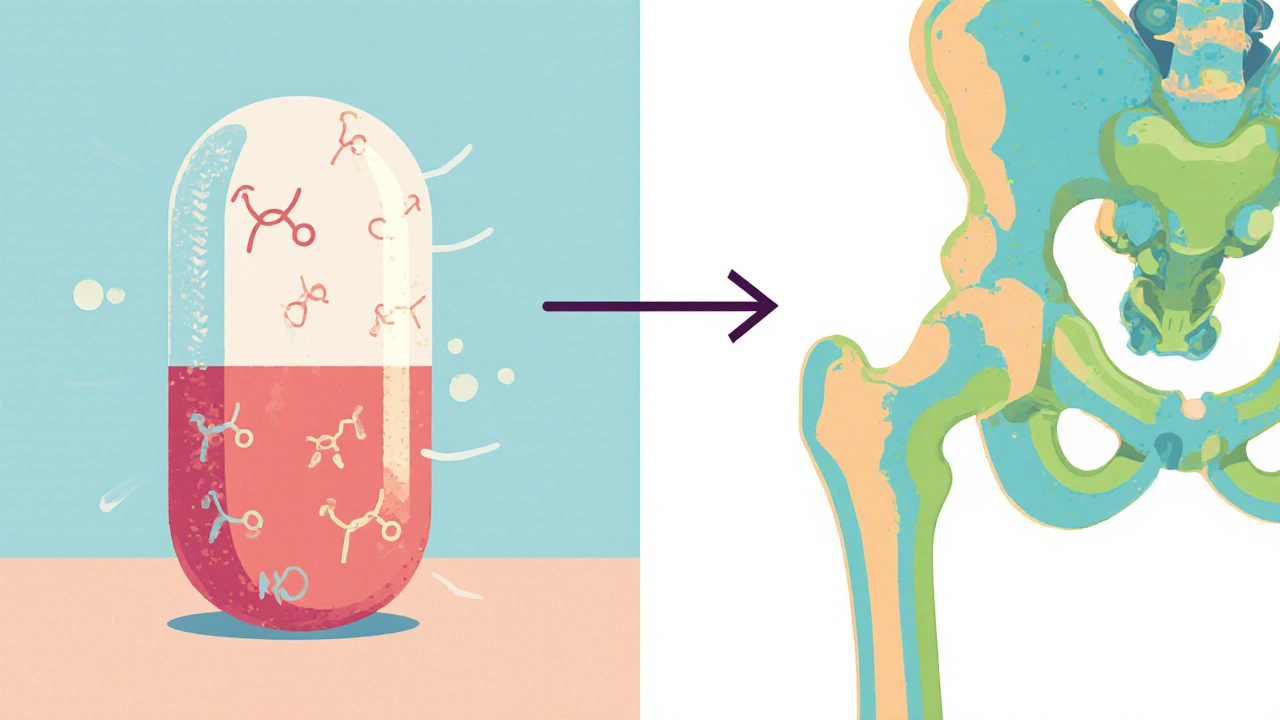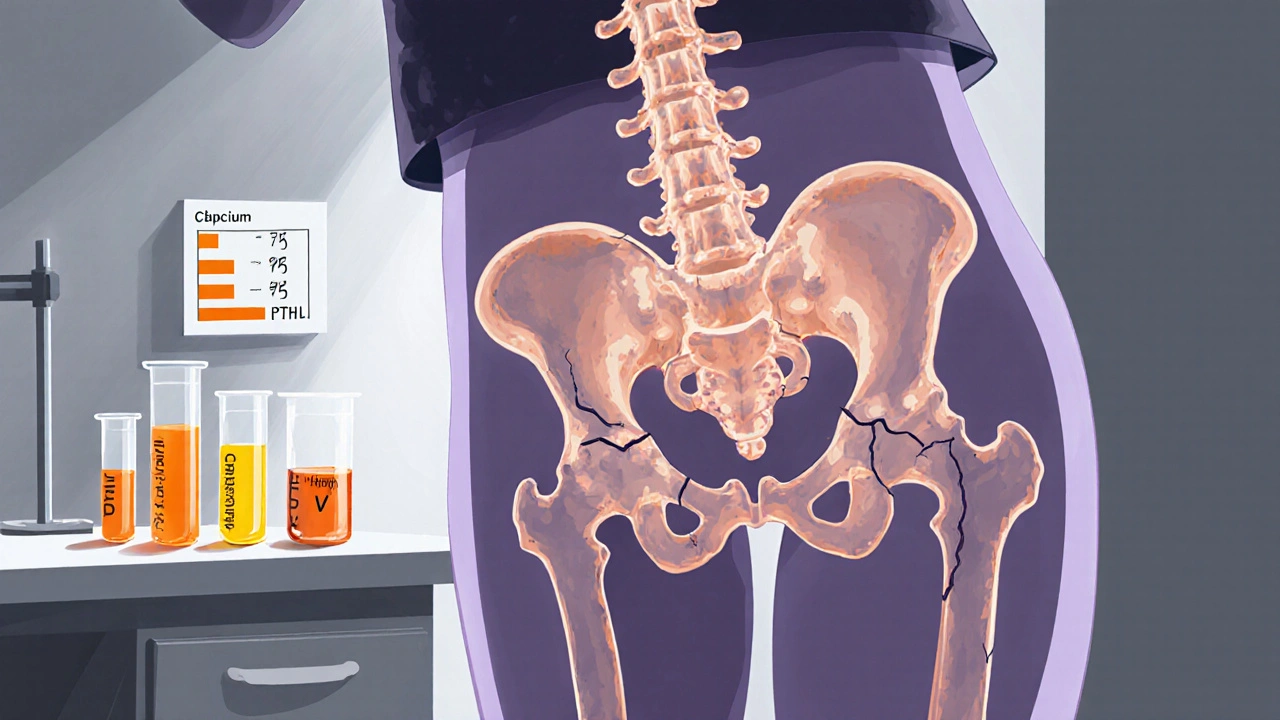
When you hear Phenytoin is a widely used antiepileptic drug that stabilises neuronal firing, it’s easy to forget that the medication also talks to your skeleton. Bone health isn’t just about calcium pills; long‑term use of certain drugs can tilt the balance between bone formation and resorption. This guide shows how phenytoin touches the bone remodeling system, what signs to watch for, and practical steps to keep your bones strong while staying seizure‑free.
How Phenytoin Interacts With Bone Metabolism
Phenytoin induces the liver enzyme CYP450 enzymes, especially CYP3A4. This boost speeds up the breakdown of vitamin D metabolites, lowering active 1,25‑di‑hydroxy‑vitamin D levels. With less vitamin D, calcium absorption in the gut drops, and serum calcium can dip below the optimal range. The body compensates by increasing parathyroid hormone (PTH), which pulls calcium from the bone matrix, accelerating bone loss.
What Happens to Your Bones?
Studies from the early 2000s to recent 2023 cohort analyses report a 30‑40 % higher incidence of osteopenia and osteoporosis among chronic phenytoin users compared with matched controls. The drug especially harms trabecular bone - the spongy interior of vertebrae - making spinal fractures more common. Key bone‑related outcomes include:
- Reduced Bone mineral density (BMD) at the lumbar spine and femoral neck.
- Higher serum alkaline phosphatase, a marker of increased bone turnover.
- Elevated fracture risk, particularly in women over 50 and men over 60 who have been on phenytoin for more than five years.
Who Is Most at Risk?
Not everyone on phenytoin will develop bone problems, but several factors raise the odds:
- Age: Bone density naturally declines after age 30; add drug‑induced loss and the effect compounds.
- Gender: Post‑menopausal women lose estrogen‑driven protection, making the vitamin D deficit more damaging.
- Duration and dose: >5 years of therapy or daily doses >300 mg increase enzyme induction.
- Nutritional status: Low dietary calcium (<800 mg/day) or insufficient sunlight exposure amplifies vitamin D deficiency.
- Co‑medications: Other enzyme‑inducing antiepileptic drugs (e.g., carbamazepine) have additive effects.

How to Monitor Your Bone Health While on Phenytoin
Regular monitoring catches problems early. Follow this schedule:
- Baseline labs: Serum calcium, phosphate, 25‑hydroxy‑vitamin D, and PTH before starting phenytoin.
- Annual labs: Repeat the same panel yearly; if vitamin D falls below 30 ng/mL, supplement.
- Bone density scan: A dual‑energy X‑ray absorptiometry (DXA) test at the lumbar spine and hip every 2‑3 years, or sooner if you have a fracture.
Practical Ways to Protect Your Bones
Even if you need to stay on phenytoin, you can blunt its impact on the skeleton:
- Vitamin D supplementation: Aim for 800-1,000 IU daily; many clinicians prescribe 2,000 IU if levels are low.
- Calcium intake: Reach 1,000 mg/day for adults under 50 and 1,200 mg/day for older adults. Dairy, fortified plant milks, or calcium carbonate tablets work well.
- Weight‑bearing exercise: Walking, jogging, or resistance training for at least 30 minutes most days stimulates bone formation.
- Avoid smoking and excess alcohol: Both accelerate bone loss and interfere with calcium balance.
- Consider bone‑preserving meds: If DXA shows T‑score ≤ ‑2.5, doctors often start bisphosphonates like Alendronate alongside calcium and vitamin D.

Comparing Phenytoin With Other Antiepileptic Drugs (AEDs)
When you discuss treatment options with your neurologist, ask about the bone‑health profile of each drug. The table below summarises the most common AEDs and their typical impact on bone metabolism.
| Drug | Enzyme induction | Vitamin D effect | Typical BMD change | Notes |
|---|---|---|---|---|
| Phenytoin | Strong inducer | ↓ 1,25‑(OH)2‑D | ‑2-4 %/yr | High fracture risk in long‑term use |
| Carbamazepine | Moderate inducer | ↓ Vitamin D modestly | ‑1-2 %/yr | Similar risk, often combined with vitamin D |
| Valproate | Minimal induction | Usually unchanged | ±0 %/yr | May cause weight gain, indirect bone risk |
| Levetiracetam | None | Unaffected | ±0 %/yr | Considered bone‑friendly |
If bone loss is a major concern, many specialists now prefer levetiracetam or newer non‑inducing agents, balancing seizure control with skeletal safety.
When to Consider Switching or Adding Therapy
A change in medication should never be abrupt; taper under medical supervision. Indicators that a switch might be wise include:
- Repeated low‑energy fractures.
- DXA T‑score ≤ ‑2.5 despite supplements.
- Persistent vitamin D levels < 20 ng/mL despite high‑dose supplementation.
In such cases, discuss alternative AEDs, combined therapy with bisphosphonates, or referral to an endocrinologist.
Key Takeaways
- Phenytoin accelerates vitamin D breakdown, leading to calcium loss and higher fracture risk.
- Age, gender, dosage, and nutrition shape individual risk.
- Baseline labs, yearly monitoring, and regular DXA scans catch bone loss early.
- Vitamin D + calcium, weight‑bearing exercise, and possibly bisphosphonates protect bones.
- Non‑inducing AEDs such as levetiracetam are alternatives when bone health is a priority.
Does phenytoin cause osteoporosis?
Long‑term phenytoin use is linked to a 30‑40 % higher chance of developing osteoporosis, especially in older adults and those with low vitamin D levels.
How often should I get a bone density scan while on phenytoin?
If you’re under 50, a DXA every 3 years is typical. Over 50 or after five years of therapy, a scan every 2 years is recommended.
Can vitamin D supplements completely offset phenytoin’s bone effects?
Supplements improve calcium absorption but may not fully reverse enzyme‑induced bone loss. Combine vitamin D with calcium, exercise, and regular monitoring for best protection.
Is it safe to switch from phenytoin to levetiracetam solely for bone health?
Switching is safe when seizure control remains stable. Discuss tapering schedules and seizure monitoring with your neurologist before making any change.
What signs suggest my bones are weakening?
Sudden low‑impact fractures, persistent back pain, loss of height, or a “tinny” sound when tapping ribs can signal reduced bone strength.
Keeping your bones healthy while taking Phenytoin bone health advice isn’t a one‑size‑fits‑all. With regular labs, smart supplementation, and the right exercise plan, you can stay seizure‑free without sacrificing skeletal strength.
13 Comments
Veronica Appleton
October 27 2025
The enzyme induction that Phenytoin causes does lower active vitamin D levels and that can reduce calcium absorption so the body ramps up PTH and starts pulling calcium from bone but it isn’t an inevitable slide into osteoporosis the way headlines suggest many clinicians actually monitor bone density in long‑term users and supplement with vitamin D and calcium when levels dip further guidelines recommend a DEXA scan after five years of therapy especially for post‑menopausal women and older men and lifestyle measures like weight‑bearing exercise and limiting alcohol also help preserve bone mass the risk is real but manageable with proactive care and patient education many studies show that with proper supplementation fracture rates drop significantly and patients can stay on Phenytoin without compromising skeletal health if you keep an eye on lab values and adjust dosing appropriately the key is regular follow‑up not panic.
the sagar
October 29 2025
Phenytoin isn’t the only culprit, watch the whole drug cocktail.
Zaria Williams
November 1 2025
Yo the bone loss thing is real but ppl need 2x calcium and vitamin D not just a quick fix lol
Ken Dany Poquiz Bocanegra
November 3 2025
It’s worth noting that the reduction in 1,25‑di‑hydroxy‑vitamin D isn’t uniform; genetic polymorphisms in CYP3A4 can amplify the effect making some individuals far more susceptible to osteoporosis.
Tamara Schäfer
November 6 2025
One thing i keep seeing is that patients who combine Phenytoin with a low‑calcium diet get hit harder i think we should stress the diet side more than just the med.
Tamara Tioran-Harrison
November 8 2025
Of course, the world will never learn that a simple multivitamin could save your spine 😒
kevin burton
November 11 2025
For patients on Phenytoin, checking serum calcium and vitamin D every six months is a practical step; it’s simple and can catch deficiencies early.
Max Lilleyman
November 13 2025
Good point on monitoring, but many forget that alkaline phosphatase spikes can also signal increased turnover 🚀
Shannon Stoneburgh
November 16 2025
Monitoring labs is fine but the real issue is that many physicians dismiss bone health as a side effect nobody cares about.
Nathan Comstock
November 18 2025
Anyone who says Phenytoin is harmless to bones clearly hasn’t read the data and is probably following a foreign agenda to downplay drug risks.
Terell Moore
November 21 2025
It’s amusing how the “experts” love to pump up the danger of an old drug while ignoring newer, more expensive alternatives that have their own hidden costs 😏
Lennox Anoff
November 23 2025
I find it ironic that a medication designed to stabilize the brain ends up destabilizing the skeleton; perhaps the medical community should prioritize holistic health over isolated seizure control.






Amber Lintner
October 24 2025
Everyone acts like Phenytoin is a death sentence for your skeleton, but honestly the drama is blown out of proportion – sure it can tip the balance, yet many patients never see a fracture.